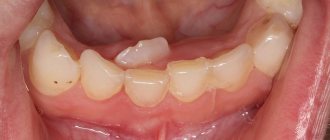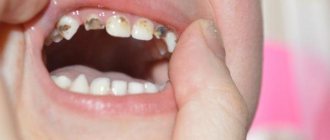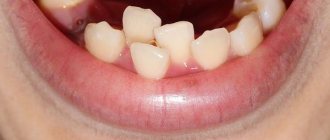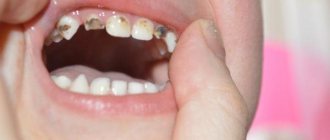How does teeth change?
The rudiments of future permanent units are located under the root of the baby tooth and are separated from it by a thin bone septum. At 6–7 years of age, osteoclasts of the connective tissue surrounding the baby tooth dissolve the mineral component of the septum and destroy it. At the same time, the pulp of the temporary unit is gradually transformed into granulation connective tissue rich in osteoclasts, which gradually destroy the dentin of the primary tooth. At the same time, the roots of the temporary units dissolve and, in fact, only the crown of the baby tooth remains. It can be easily removed on its own, with the help of the dentist’s manipulations, or it can be pushed out by an actively growing molar (permanent) tooth.
Anatomy of permanent teeth The permanent units of a child (and an adult) have a complex anatomy.
Visually, the tooth consists of three parts - crown, neck, roots.
- The crown is the visible part of the tooth that rises above the gum.
- The neck is the part of the tooth at the gum level, in the place where the crown meets the root, and the enamel of the unit turns into cement.
- The root is the part of the unit invisible to the eye, located in the alveolar socket. The base of each unit is made of dentin, a hard tissue. In the coronal part, dentin is covered with enamel, and in the root part there is cement. Inside the dentin is the dental pulp - loose fibrous soft connective tissue, penetrated by a large number of blood and lymphatic vessels and nerve endings. Passing along the root canal, through the apical foramen located on the upper part of the root, they communicate with the main neurovascular bundle, providing nutrition to the tooth, drainage of excess fluid and its innervation.
Normally, by the age of 13, when a permanent bite is formed, a child has 28 permanent teeth. At the age of 17 - 25 years, third molars (wisdom teeth) erupt and the number of units may increase - 32 teeth.
How many teeth should a child have?
It all depends on age. The maximum number of teeth in the period from birth to 5-6 years is 20 - these are milk teeth. Then, until the age of 15-16, the molars begin to erupt, pushing out the milk teeth. Ultimately, their number grows to 28.
The latest are the third molars. They grow only after 18 years of age, but not everyone has them.
It is worth noting that the period of formation and eruption of baby teeth is very individual. In some children, all 20 teeth grow by the age of 2, while in others - by 2.5 or later. Such delays within a year are considered normal and are not a developmental anomaly.
If teeth do not start cutting in the first year of the baby’s life, you should consult a doctor to find out the reasons.
To the list of posts
Timing and order of eruption of permanent teeth
Normally, the eruption of permanent units occurs 3 to 4 months after the loss of baby teeth. In girls, this process occurs a little earlier and faster than in boys. In both sexes, the first lower molars appear first. Then the sequence of eruption of permanent teeth is approximately the same as for milk teeth and looks as follows.
- 6 - 7 years - central incisors.
- 7 - 8 years - lateral incisors.
- 9 - 12 years - fangs.
- 10 - 12 years - premolars.
- 10 - 12 years - molars.
The eruption of the second molars completes the formation of the permanent dentition.
How many baby teeth do children have?
Milk teeth and even some molars begin to form at the stage of intrauterine development. Of course, a child has no visible teeth at birth - they begin to erupt only after 6 months. During this six-month period, they are hidden under the gums, but slowly develop and form, beginning to move outward.
In total, a child grows 20 baby teeth:
- Central and lateral incisors – 8.
- Fangs – 4.
- First and second molars – 8.
Their main function is to form a space where molars will then grow.
The main differences between baby teeth and permanent teeth
Unlike 28 permanent teeth, the primary dentition requires the presence of 20 units. At the same time, they have a number of characteristic features.
- Smaller in size compared to permanent teeth.
- White with a slightly blue tint (permanent units have a slightly yellowish tint).
- Less developed and slightly short roots compared to permanent teeth.
- The enamel of primary teeth is poorly formed - thinner.
- Milk units can be erased (permanent ones can too, but this is considered a pathology).
As the child grows, baby teeth fall out on their own - this is the norm. The permanent dentition units should not fall out on their own.
What should parents do?
The process of changing teeth in children worries parents, but this is quite natural, and most children do not experience significant pain. However, this does not relieve parents of the need to constantly monitor the condition of their child’s oral cavity. There is no need to remove baby teeth yourself. When the time comes to say goodbye to a tooth, a certain mechanism is activated in the child’s body that dissolves the milk tooth roots. You should seek help from a specialist only if the baby tooth does not want to fall out, but the permanent one is already beginning to appear.
After a tooth falls out, you may experience some bleeding. If desired, have your child rinse his mouth with a solution of soda with a drop of iodine as a preventative measure.
If you have a problem similar to that described in this article, be sure to contact our specialists. Don't diagnose yourself!
Why you should call us now:
- We will answer all your questions in 3 minutes
- Free consultation
- The average work experience of doctors is 12 years
- Convenient location of clinics
Single contact phone number: +7
Make an appointment
How to determine that a child will soon have molars?
An increase in jaw size is the main sign of a future change of teeth. Visually this may not be noticeable. But the appearance of three and diastema (gaps) between the baby teeth indicates that the child’s jaw is growing and preparing for the formation of a permanent bite.
The following signs are purely individual - they may or may not be present in the child.
- Increased salivation.
- Redness, swelling of the gums and oral mucosa.
- Sore gums.
- Unpleasant itching of the gums.
- Increased body temperature.
- Unreasonable cough, runny nose.
- Stool disorder.
- General malaise, lethargy.
- Loss of appetite.
- Sleep disturbance or, on the contrary, drowsiness.
- Anxiety, irritation, whims.
Important! During the period of permanent teeth erupting, parents should monitor the condition of the child, the oral cavity and gums. If symptoms that cause concern appear, you should immediately consult a doctor - a pediatrician or pediatric dentist.
Typical problems.
The most typical problem between the ages of 3 and 6 years is the development of caries of primary teeth in the area of the first and second primary molars. The narrow interdental spaces between the first and second primary molars, which are difficult for a child to reach, are an ideal place for plaque to accumulate. As a result, caries forms on the surface of the teeth hidden from the eyes of parents (between the 4th and 5th milk teeth). Being unnoticed, the carious process quickly progresses, complicated by inflammation of the nerve of the tooth (pulpitis).
With poor oral hygiene and a large number of carious teeth, caries of the permanent molar (6th tooth) often develops, high-quality treatment of which is only possible by a pediatric dentist.
Possible problems
Despite the fact that changing teeth is a natural physiological process, some children and their parents may encounter a number of problems that require contacting a pediatric dentist.
No molars
The absence of permanent units can be caused by congenital edentia - the complete or partial absence of tooth buds.
Another reason for the absence of molars is previous inflammatory diseases - periostitis or periodontitis, resulting from progressive caries. Inflammatory diseases of the periosteum and periodontal tissues have an extremely negative effect on the condition of the tooth buds and can lead to their death.
Important! It is absolutely necessary to treat baby teeth for caries. You should not assume that the problem will go away on its own with the change of teeth. The progression of the disease can negatively affect the health of the tooth buds.
Molar tooth hurts
The enamel of newly emerging permanent teeth is still poorly formed. The low level of its mineralization makes teeth vulnerable to cariogenic microflora. This can lead to the development of caries and cause pain.
Due to poorly formed enamel, tooth sensitivity to external irritants (cold, hot, sour, sweet) may increase, which is also accompanied by painful sensations.
Important! Normally, permanent teeth do not hurt. If pain occurs, you should contact your pediatric dentist. The specialist will determine the cause of the pain, carry out the necessary treatment, fluoridation or remineralization of tooth enamel.
Molars grow crooked
The incorrect position of permanent teeth can be caused by two reasons - the growth of the permanent unit outpaces the process of loss of baby teeth or they were removed ahead of schedule, which led to incorrect formation of the rudiments of permanent teeth.
In this case, there is only one way out - orthodontic treatment of malocclusion.
Important! A malocclusion must be corrected. The sooner you contact a dentist, the more successful the treatment will be. The child will be prescribed to wear removable or fixed orthodontic appliances that will help straighten the permanent teeth and bite.
Injuries
Due to their activity and lack of experience, children can accidentally injure a newly emerging permanent tooth. Due to mechanical damage, cracks and chips may appear on it. The damage looks unattractive. Caring for such teeth is complicated, since food debris can get stuck in the cracks, which will certainly lead to the development of caries.
Important! If a child accidentally injures a permanent tooth, it is necessary to seek help from a dentist. The specialist will assess the complexity and depth of the damage and will build up the missing volume of tooth tissue with composite materials.
Tooth loss
Loss of healthy permanent teeth can only occur as a result of severe trauma to the jaw, for example, during a child’s fall or fight. A diseased molar may fall out on its own. In this case, you will also need to consult a specialist. Most likely, the child will undergo temporary prosthetics for the lost unit, which will not disrupt the formation of a correct permanent bite.
The tooth is loose
Looseness of a permanent tooth is an alarming symptom indicating a pathology of the dentofacial apparatus or the presence of inflammation. Consultation with a specialist is required!
Bookmarking teeth
The formation of baby teeth occurs at approximately 4-6 weeks of fetal development. At the same time, the formation of the fundamental elements occurs much later - during the first months of the child’s life. For this reason, new mothers who are bottle-feeding are strongly recommended to supplement their baby’s diet with calcium. This substance promotes the proper formation of tooth enamel.
At an early age, unprotected baby teeth are extremely susceptible to carious lesions. Parents should monitor this closely, as infection can subsequently cause destruction of permanent teeth. The fact is that the rudiments of permanent teeth are in close proximity to the roots of milk teeth, so as soon as you discover dark spots on your child’s enamel, immediately go to pediatric dentistry.
What to do if a child does not allow or is afraid to have his teeth treated?
Many children experience panic, so it is very important to intelligently approach the question of how to properly persuade a small child to have their teeth treated. To make the process painless and, perhaps, even positive, adhere to the following rules:
- Meet the doctor.
This should be done not at the moment when the tooth is already sick, but in advance - during a preventive examination.
- Motivation.
The child does not know why this is needed and what awaits him in general, so you should tell him about the importance of the procedure or, for example, show him in a playful way on his favorite toy.
- Elimination of physical force.
If a child resists, is capricious and protests, he should not be forced into the dental chair. This will not only traumatize the psyche, but will also completely discourage you from visiting dentists. Here it is better to act carefully - persuade, talk about the great benefits of treatment, or offer a new toy as a present.
- Timing.
If treatment is required, you should see a doctor without delay, but you should also consider the child’s needs. If he is used to, for example, sleeping at a certain time, you should not go to the doctor at that very moment. This is fraught with bad mood and whims. First, let your child sleep, and only after that get ready for the dentist. The same goes for eating, playing and other hobbies.
- Do not lie.
Many parents say that the doctor will only look and do nothing. This is a very big mistake, because the child expects one thing, but in the end it turns out something completely different. It will be better if you tell him the truth in a positive way.
Another good way to motivate your child is by example. If you regularly visit a doctor for preventive purposes and talk about the benefits of procedures, then your child will follow your example.
Possible problems when changing baby teeth
Common dental pathologies when changing a primary dentition to a permanent one include:
- Shark teeth. A phenomenon in which baby and permanent teeth are located parallel to each other, in 2 rows. This arrangement can interfere with the normal development of the dental system. But in most cases, the temporary root becomes loose, and the “extra” tooth falls out on its own. If this does not happen, removal at the doctor's office is recommended.
- Increased pain. Sometimes a change in the milk bite is accompanied by increased body temperature, redness of the gums and severe pain. These symptoms usually accompany early or late change of teeth. Inflammatory diseases of the oral cavity may also be the cause.
- The appearance of a hematoma.
In rare cases, when molars erupt, a hematoma occurs on the gum in the form of a small bubble with an accumulation of blood. This occurs due to severe eruption, which leads to rupture of blood vessels. The gums may be pale in color. Pain and discomfort occurs. If suppuration occurs, medical attention is required.
If pathological phenomena do not go away for a long time, and the child is irritable and complains of pain, be sure to visit the dentist.
Reasons for late eruption
Normally, after a baby tooth falls out, it takes 1-2 months for the permanent tooth to erupt. This is the longest period. In most cases, the rudiments of a permanent tooth can already be seen at the site of the lost tooth.
But, if a child’s toothless smile persists for 3 months or more, then this is a cause for concern for parents.
Let's consider why such dental pathology occurs:
- Retention
– a common condition that mainly affects the incisors and canines. They cannot erupt due to dense gums or because they rest against neighboring teeth. There are complete and partial retention. With the full form, a healthy root is visible in the picture, but it is completely under the gum. With partial retention, only part of the crown is visible. In this case, surgical assistance is required.
- Edentia
– a congenital pathology in which there is a lack of rudiments of permanent dental units. Can be complete or partial (sparse teeth). A rare disease. Orthopedic treatment is required as early as possible.
- Impact
– delayed eruption in this pathology is associated with a mechanical obstacle, that is, the child has a supernumerary of dental units. In this case, the permanent root simply does not have room to erupt. Impaction can only be detected using a panoramic x-ray of the jaw.
The sooner the child is examined by a doctor, the higher the chance of having an even and complete dentition.
What to do when teething?
The first teeth erupting will cause discomfort in the child, and this is a natural process. During this period, salivation increases, and a runny nose may occur due to the eruption of the upper teeth. The normal pace is for new teeth to appear every few weeks.
Be prepared for the fact that the child will be capricious and refuse to eat, and his temperature may rise. To make this period easier, you can use special teething toys. During this period, the gums become inflamed and cause discomfort - they can itch and hurt. Talk to your dentist: There are safe cooling gels for children that can help reduce the intensity of teething and teething symptoms in children.
It is also recommended to replace drinks with plain water. Juices and other drinks that contain sugar create an acidic environment in the mouth. Because of this, an inflammatory process may begin. Care should be taken to disinfect pacifiers and toys that children may put in their mouths.
The first teeth appear at the age of six months. The first chewing teeth appear between the ages of 1 and 1.5 years. Fangs are cut between the ages of 2 and 2. After this, by the age of 3, the following chewing teeth appear. Each new group requires attention. Thus, it is important to brush your chewing teeth well after eating, since the enamel of baby teeth is quite weak. Retention of food on the surface can easily cause inflammation.
It is also important to ensure that the child weans the habit of the pacifier and stops putting his fingers in his mouth. If this does not happen, an incorrect bite will be formed.










